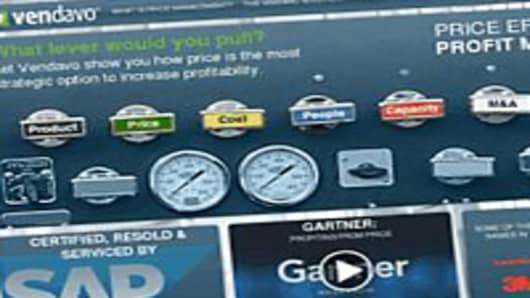In a year of severe drought and continued economic sluggishness, U.S. food and agriculture companies have struggled to keep pace with higher costs and very little growth in demand. Pricing is their last weapon in the fight to remain profitable.
As a result, more and more food producers are turning to technology to boost their bottom lines.
“With multiple types of products and multiple sects of customers in different markets, their [profit and loss statements] are incredibly complex," said Matt Johnson, managing partner at consultancy firm Simon Kucher. "Automated tools to execute their pricing strategies ... are pretty crucial.”
The tool is called price optimization software. It mixes a complicated soup of operations analysis, forecasting and statistics with a company’s own data and comes up with the highest possible value for the company's products. It's offered by a variety of vendors, such as Pros Pricing, Signal Demand, Vendavo, and Vistaar. (More:Outdated Business Model? Try Predictive Analytics)
Pricing optimization is a by-product of the big data movement, which gained momentum in the airline industry in the 1990s. Companies began to generate a tremendous amount of data, and by the mid-2000s, analytical software became sophisticated enough to pull it all together. The pricing focus developed because ‘big data’ systems lacked price management capabilities.
“When we started, most companies were taking an ad-hoc approach to price,” said Craig Zawada, senior vice president at Pros Holdings, the parent company of ProsPricing.
Price optimization software is still used as a complement to big data systems. Smaller vendors have also sprouted up to serve companies with much smaller data sets, but the main business remains in large-cap companies.
The bigger food companies, in particular, face a highly volatile pricing environment driven by fluctuations in raw material, energy and freight costs. Nearly half of companies in the sector actually say they’re in a “pricing war,” according to a recent Simon Kucher pricing survey. They consider the new software one way to get an edge over the competition.
Among the companies using this new technology are ConAgra Mills , Hormel, Cargill, National Frozen Foods, Ventura Foods, and Michaels Foods.
“In the commodity market, you’re trying to create value in separation. We produce over 800 different flour SKUs [stock-keeping units] in 23 different facilities," said Bill Stoufer, President of ConAgra Mills, in an interview with Signal Demand. "To do that, we have to optimize and run them at the right time and the right price for our customers.”
ConAgra is the third-largest miller in North America, and it relies on Signal Demand software, which ConAgra says has led to increased profit margins. (More:15 Surprising Global Technology Cities)
Whether or not they are attributable to software-related improvements, the operating margins of publicly traded food companies ConAgra and Hormel are 5.8 percent and 8.9 percent respectively, according to their latest annual filings. Both profit margins are significantly higher than the current food sector average of 1.6 percent.
At the very least, it’s fair to assume price optimization software helped. Simon Kucher research shows a 2 to 4 percent average increase in margins enabled from this type of software. The firm is a consultancy and does not sell the software.
What's the big deal?
Wall Street’s sector research reveals just how important pricing is to these companies.
“Volume declines continue to pressure the broader food group,” Morgan Stanley reports in September’s research note on the sector. The note depicts this decline, graphing volume, sales growth, and pricing data together over the past 12 months.
While the volume numbers came in negative each month, food companies posted positive sales growth by increasing pricing during these same months. In other words, they’re selling less food for more money.
This is where pricing optimization comes in. If the only lever you’ve got is higher prices, software designed to find pricing bandwidth starts to sound like a good idea. This might be why Pros Pricing, for example, has seen a 20 percent increase in revenue year-over-year, by the end of the second quarter 2012.
“Companies are using price analysis much more frequently than they have in the past. Because with cost volatility as high as it is, a CFO doesn’t always know what earnings are going to be from the quarter to the next,” said Craig Zawada of ProsPricing. “They’re using the software now because they need the visibility of where they are being affected, and are then able to respond quickly.” (More:Get a Tiny Job, Earn a Tiny Payment. Repeat.)
Zawada says interest among food companies increased over the summer, when the Midwest drought was at its worst. However, volatility in commodity costs is not a short-term phenomenon, and most large cap businesses in one way or another must find a way to mitigate it year in and year out. The drought may have acted as a catalyst for some companies to buy the software, but the purpose of the product is not a solution to a one-off event.
Many players in the sector agree, and are spending millions on long-term pricing solutions. The cost of hiring a consulting firm to step in and create a strategy is usually between half a million and $2 million per project initiative, according to Matt Johnson of Simon Kucher consulting.
Comparatively, pricing software can cost anywhere between $1 and $10 million, depending on the size of the business and whether it must be integrated with larger back office software, such as Oracleor SAP systems.
These solutions aren’t cheap but companies—both in and outside of the food sector—who have invested in the technology say it’s worth it.
They may be heeding the 2011 comments from Warren Buffett to the Financial Crisis Inquiry Commission, when he said: “The single most important decision in evaluating a business is pricing power. If you’ve got the power to raise prices without losing business to a competitor, you’ve got a very good business.”



